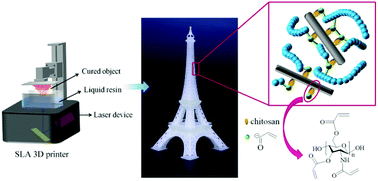Photocurable modification of inorganic fillers and their application in photopolymers for 3D printing†
Abstract
3D printing technology has recently gained tremendous interest and has applications in both industry and daily life, especially the stereolithography (SLA) technique. However, the defective properties of photopolymers restrict the development of SLA. In this paper, we report a method for enhancing the properties of a photosensitive resin by adding inorganic fillers (calcium sulfate whiskers and calcium sulfate particles, named CSW and CSP). Both kinds of fillers were firstly coated with chitosan and then modified by acryloyl chloride. FTIR, water contact angle (WCA) and thermogravimetric (TG) analysis showed that the modification was successful. The optimum concentration of chitosan solution was determined by studying the mechanical performance. The photocuring kinetics of the resins with different filler contents were studied via real-time IR spectroscopy, which provided insights into the effect of inorganic fillers on the photopolymerization reaction. Mechanical properties were determined based on the samples printed using a SLA 3D printer and the results showed that the tensile strength and impact strength of the cured samples containing 5% modified CSW were increased by 19.4% and 6.6%, respectively, and those of the cured samples containing 10% modified CSP were increased by 35.5% and 41.6%, respectively, compared to the cured pure resin. The improvement of the tensile strength can be observed from the tensile fracture surface as well. Dynamic mechanical analysis revealed that the storage modulus, glass transition temperature (Tg) and the resulting crosslinking density of the samples containing modified fillers were lower than those of the cured pure resin, but higher than those of their counterparts, i.e. samples containing unmodified fillers. This work demonstrated a simple and convenient way to strengthen photocuring materials both in terms of tensile strength and impact strength and the printed models exhibited high accuracy and resolution, indicating that the hybrid photopolymers could be a promising candidate for SLA 3D printing.



 Please wait while we load your content...
Please wait while we load your content...